Munson B.R. Fundamentals of Fluid Mechanics
Подождите немного. Документ загружается.

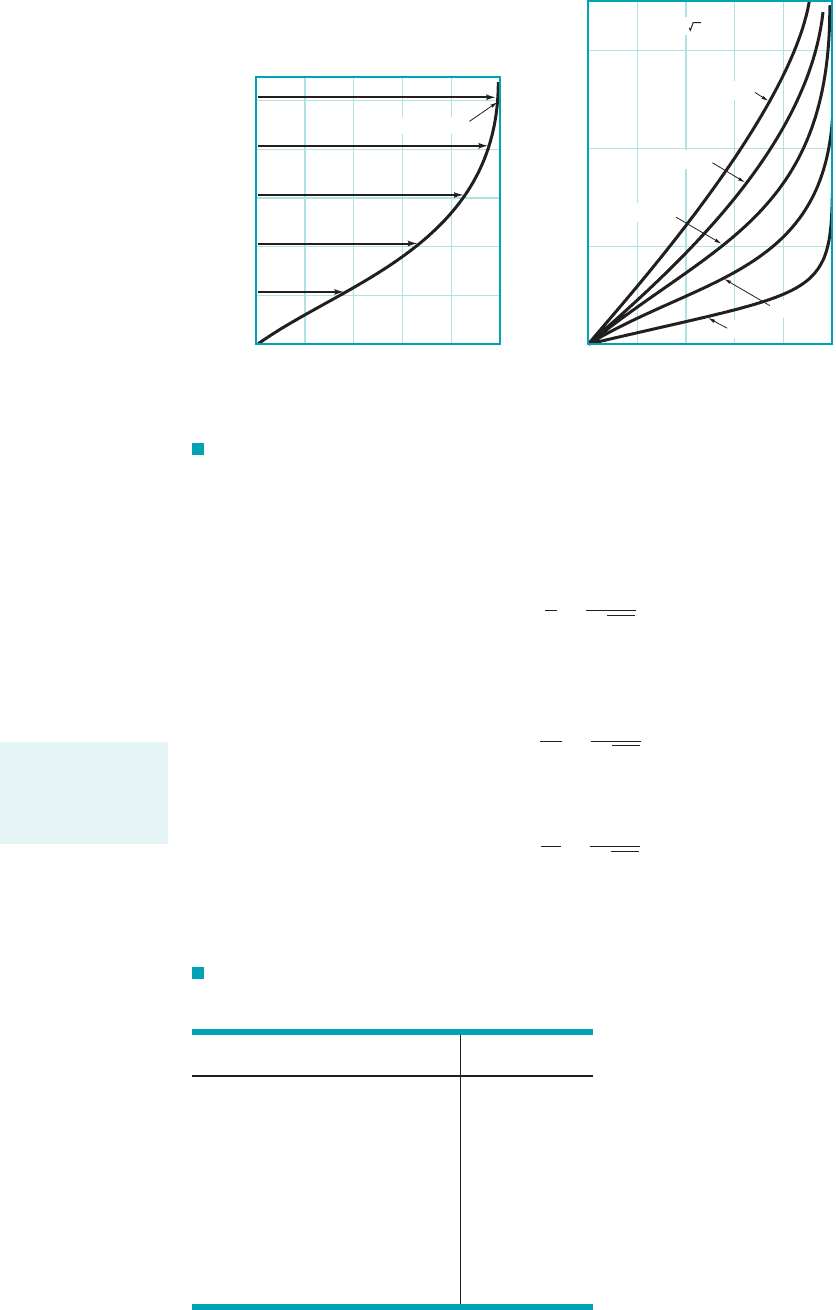
or
where It can also be shown that the displacement and momentum thicknesses are
given by
(9.16)
and
(9.17)
As postulated, the boundary layer is thin provided that is large as Re
x
S 2.1i.e., d
x S 0Re
x
™
x
0.664
1Re
x
d*
x
1.721
1Re
x
Re
x
Ux
n.
d
x
5
1Re
x
9.2 Boundary Layer Characteristics 477
F I G U R E 9.10 Blasius boundary layer profile: (a) boundary layer profile in
dimensionless form using the similarity variable (b) similar boundary layer profiles at
different locations along the flat plate.
H,
x
4
= 16 x
1
x
3
= 9 x
1
x
2
= 4 x
1
x = x
1
x
5
= 25 x
1
δ ∼
x
u
U
(b)
0
δ
1
δ
1
δ
2
= 2
δ
1
δ
3
= 3
y
1.00.80.60.40.20
0
0
1
2
3
4
5
u
__
U
η
≈ 0.99 at ≈ 5
(a)
u
__
U
f
′ ( ) =
η
= y
(
)
U
__
vx
1
/
2
η
TABLE 9.1
Laminar Flow along a Flat Plate
(the Blasius Solution)
( ) () ()
0 0 3.6 0.9233
0.4 0.1328 4.0 0.9555
0.8 0.2647 4.4 0.9759
1.2 0.3938 4.8 0.9878
1.6 0.5168 5.0 0.9916
2.0 0.6298 5.2 0.9943
2.4 0.7290 5.6 0.9975
2.8 0.8115 6.0 0.9990
3.2 0.8761 1.0000
HfⴕHⴝ u
UHfⴕ
1兾2
U
NxH ⴝ y
For large Reynolds
numbers the bound-
ary layer is rela-
tively thin.
JWCL068_ch09_461-533.qxd 9/23/08 11:47 AM Page 477
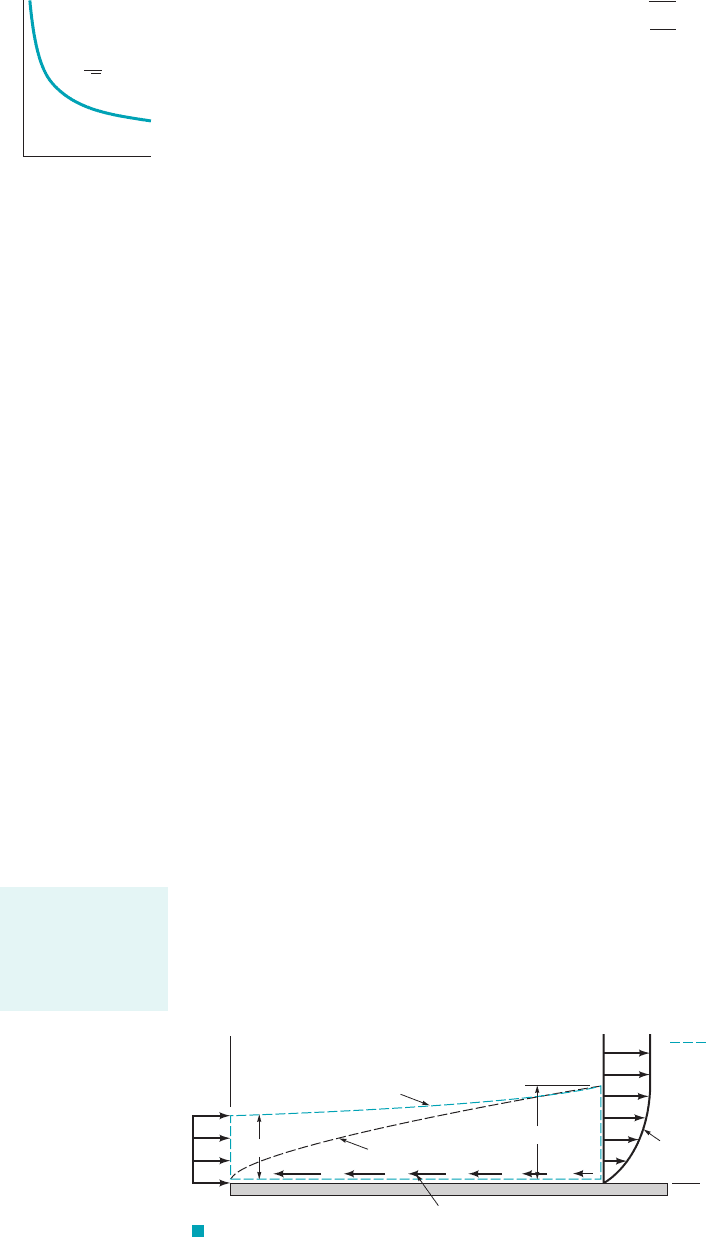
With the velocity profile known, it is an easy matter to determine the wall shear stress,
where the velocity gradient is evaluated at the plate. The value of at
can be obtained from the Blasius solution to give
(9.18)
As indicated by Eq. 9.18 and illustrated in the figure in the margin, the shear stress decreases with
increasing x because of the increasing thickness of the boundary layer—the velocity gradient at
the wall decreases with increasing x. Also, varies as not as U as it does for fully devel-
oped laminar pipe flow. These variations are discussed in Section 9.2.3.
9.2.3 Momentum Integral Boundary Layer Equation for a Flat Plate
One of the important aspects of boundary layer theory is the determination of the drag caused by
shear forces on a body. As was discussed in the previous section, such results can be obtained from
the governing differential equations for laminar boundary layer flow. Since these solutions are ex-
tremely difficult to obtain, it is of interest to have an alternative approximate method. The momen-
tum integral method described in this section provides such an alternative.
We consider the uniform flow past a flat plate and the fixed control volume as shown in Fig.
9.11. In agreement with advanced theory and experiment, we assume that the pressure is constant
throughout the flow field. The flow entering the control volume at the leading edge of the plate [sec-
tion 112] is uniform, while the velocity of the flow exiting the control volume [section 122] varies
from the upstream velocity at the edge of the boundary layer to zero velocity on the plate.
The fluid adjacent to the plate makes up the lower portion of the control surface. The upper
surface coincides with the streamline just outside the edge of the boundary layer at section 122. It
need not 1in fact, does not2coincide with the edge of the boundary layer except at section 122. If
we apply the x component of the momentum equation 1Eq. 5.222to the steady flow of fluid within
this control volume we obtain
where for a plate of width b
(9.19)
and is the drag that the plate exerts on the fluid. Note that the net force caused by the uniform
pressure distribution does not contribute to this flow. Since the plate is solid and the upper surface
of the control volume is a streamline, there is no flow through these areas. Thus,
or
(9.20)d ⫽ rU
2
bh ⫺ rb
冮
d
0
u
2
dy
⫺d ⫽ r
冮
112
U1⫺U2 dA ⫹ r
冮
122
u
2
dA
d
a
F
x
⫽⫺d ⫽⫺
冮
plate
t
w
dA ⫽⫺b
冮
plate
t
w
dx
a
F
x
⫽ r
冮
112
uV ⴢ nˆ dA ⫹ r
冮
122
uV ⴢ nˆ dA
U
3
Ⲑ
2
,t
w
t
w
⫽ 0.332U
3
Ⲑ
2
B
rm
x
y ⫽ 0
0u
Ⲑ
0yt
w
⫽ m
10u
Ⲑ
0y2
y⫽0
,
478 Chapter 9 ■ Flow over Immersed Bodies
x
τ
w
τ
~
w
√
x
1
F I G U R E 9.11 Control volume used in the derivation of the
momentum integral equation for boundary layer flow.
Streamline
Boundary layer edge
Control
surface
x
u
U
(2)(1)
U
y
h
δ
(x)
τ
w
(x)
The drag on a flat
plate depends on
the velocity profile
within the bound-
ary layer.
JWCL068_ch09_461-533.qxd 9/23/08 11:47 AM Page 478

Although the height h is not known, it is known that for conservation of mass the flowrate
through section 112must equal that through section 122, or
which can be written as
(9.21)
Thus, by combining Eqs. 9.20 and 9.21 we obtain the drag in terms of the deficit of momentum
flux across the outlet of the control volume as
(9.22)
The idea of a momentum deficit is illustrated in the figure in the margin. If the flow
were inviscid, the drag would be zero, since we would have and the right-hand side of
Eq. 9.22 would be zero. 1This is consistent with the fact that if .2Equation 9.22
points out the important fact that boundary layer flow on a flat plate is governed by a balance
between shear drag 1the left-hand side of Eq. 9.222and a decrease in the momentum of the
fluid 1the right-hand side of Eq. 9.222. As x increases, increases and the drag increases. The
thickening of the boundary layer is necessary to overcome the drag of the viscous shear stress
on the plate. This is contrary to horizontal fully developed pipe flow in which the momentum
of the fluid remains constant and the shear force is overcome by the pressure gradient along
the pipe.
The development of Eq. 9.22 and its use was first put forth in 1921 by T. von
Kármán 11881–19632, a Hungarian/German aerodynamicist. By comparing Eqs. 9.22 and 9.4 we
see that the drag can be written in terms of the momentum thickness, as
(9.23)
Note that this equation is valid for laminar or turbulent flows.
The shear stress distribution can be obtained from Eq. 9.23 by differentiating both sides with
respect to x to obtain
(9.24)
The increase in drag per length of the plate, occurs at the expense of an increase of the
momentum boundary layer thickness, which represents a decrease in the momentum of the fluid.
Since 1see Eq. 9.192it follows that
(9.25)
Hence, by combining Eqs. 9.24 and 9.25 we obtain the momentum integral equation for the bound-
ary layer flow on a flat plate
(9.26)
The usefulness of this relationship lies in the ability to obtain approximate boundary layer
results easily by using rather crude assumptions. For example, if we knew the detailed velocity
profile in the boundary layer 1i.e., the Blasius solution discussed in the previous section2, we could
evaluate either the right-hand side of Eq. 9.23 to obtain the drag, or the right-hand side of Eq. 9.26
to obtain the shear stress. Fortunately, even a rather crude guess at the velocity profile will allow
us to obtain reasonable drag and shear stress results from Eq. 9.26. This method is illustrated in
Example 9.4.
t
w
⫽ rU
2
d™
dx
dd
dx
⫽ bt
w
dd ⫽ t
w
b dx
dd
Ⲑ
dx,
dd
dx
⫽ rbU
2
d™
dx
d ⫽ rbU
2
™
™,
d
m ⫽ 0t
w
⫽ 0
u K U
d ⫽ rb
冮
d
0
u1U ⫺ u2 dy
rU
2
bh ⫽ rb
冮
d
0
Uu dy
Uh ⫽
冮
d
0
u dy
9.2 Boundary Layer Characteristics 479
Drag on a flat plate
is related to mo-
mentum deficit
within the bound-
ary layer.
U – u
u
(U – u)
u
y
y
δ
δ
JWCL068_ch09_461-533.qxd 9/23/08 11:47 AM Page 479
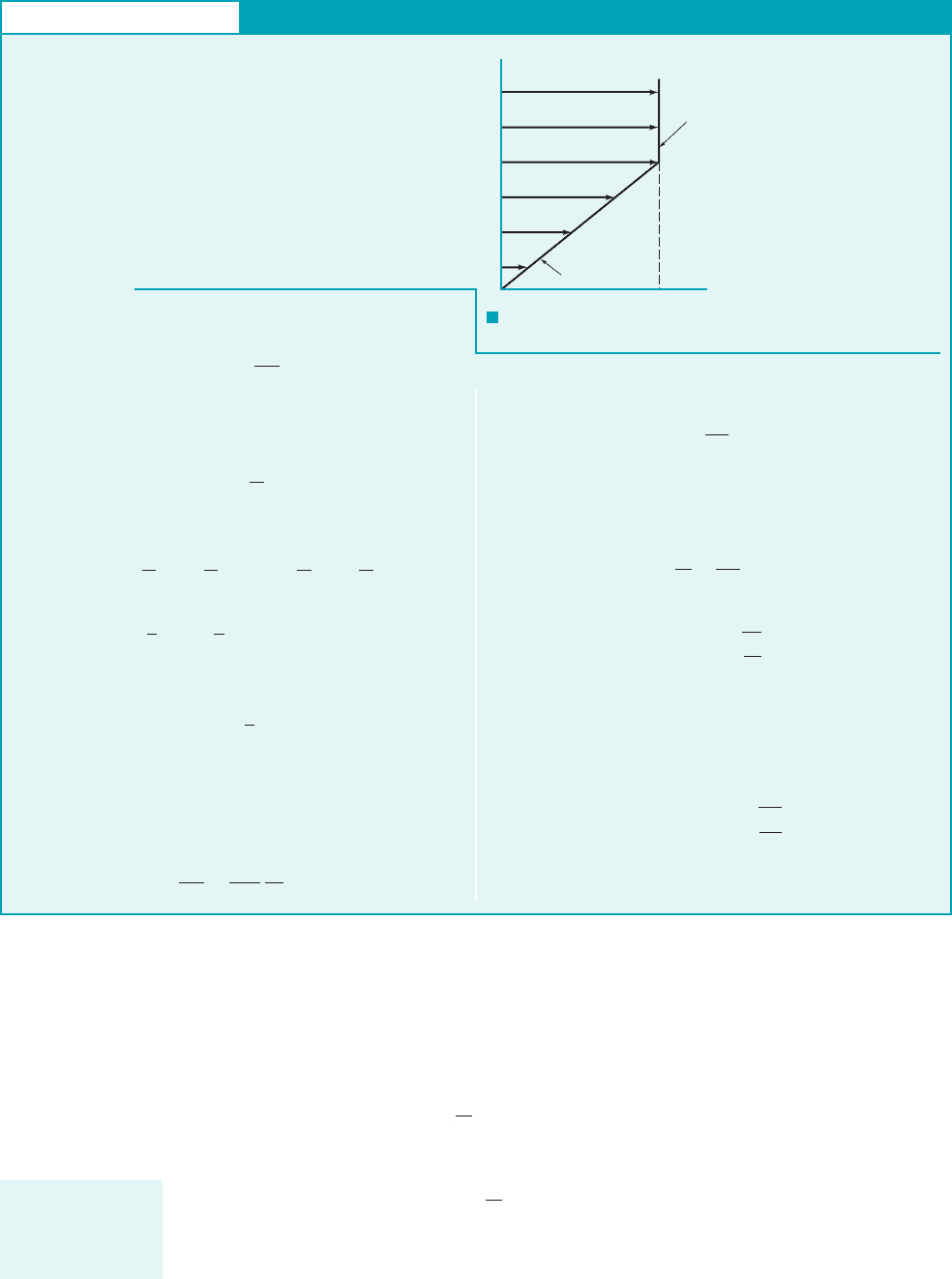
As is illustrated in Example 9.4, the momentum integral equation, Eq. 9.26, can be used
along with an assumed velocity profile to obtain reasonable, approximate boundary layer results.
The accuracy of these results depends on how closely the shape of the assumed velocity profile
approximates the actual profile.
Thus, we consider a general velocity profile
and
where the dimensionless coordinate varies from 0 to 1 across the boundary layer. The
dimensionless function can be any shape we choose, although it should be a reasonableg1Y2
Y y
d
u
U
1
for
Y 7 1
u
U
g1Y2
for
0 Y 1
480 Chapter 9 ■ Flow over Immersed Bodies
GIVEN Consider the laminar flow of an incompressible fluid
past a flat plate at The boundary layer velocity profile is
approximated as for and for
as is shown in Fig. E9.4.
FIND Determine the shear stress by using the momentum inte-
gral equation. Compare these results with the Blasius results
given by Eq. 9.18.
y 7 d,u U0 y du Uy
d
y 0.
S
OLUTION
F I G U R E E9.4
Momentum Integral Boundary Layer Equation
or
This can be integrated from the leading edge of the plate,
1where 2to an arbitrary location x where the boundary layer
thickness is The result is
or
(4)
Note that this approximate result 1i.e., the velocity profile is not ac-
tually the simple straight line we assumed2compares favorably with
the 1much more laborious to obtain2Blasius result given by Eq. 9.15.
The wall shear stress can also be obtained by combining Eqs.
1, 3, and 4 to give
(Ans)
Again this approximate result is close 1within 13%2to the
Blasius value of given by Eq. 9.18.t
w
t
w
0.289U
3
2
B
rm
x
d 3.46
B
nx
U
d
2
2
6m
rU
x
d.
d 0
x 0
d dd
6m
rU
dx
y
U
u
0
u = Uy/
δ
δ
u = U
E
XAMPLE 9.4
From Eq. 9.26 the shear stress is given by
(1)
while for laminar flow we know that For the
assumed profile we have
(2)
and from Eq. 9.4
or
(3)
Note that as yet we do not know the value of 1but suspect that it
should be a function of x2.
By combining Eqs. 1, 2, and 3 we obtain the following differ-
ential equation for
mU
d
rU
2
6
dd
dx
d:
d
™
d
6
冮
d
0
a
y
d
b a1
y
d
b dy
™
冮
q
0
u
U
a1
u
U
b dy
冮
d
0
u
U
a1
u
U
b dy
t
w
m
U
d
t
w
m10u
0y2
y0
.
t
w
rU
2
d™
dx
Approximate veloc-
ity profiles are used
in the momentum
integral equation.
JWCL068_ch09_461-533.qxd 9/23/08 11:47 AM Page 480
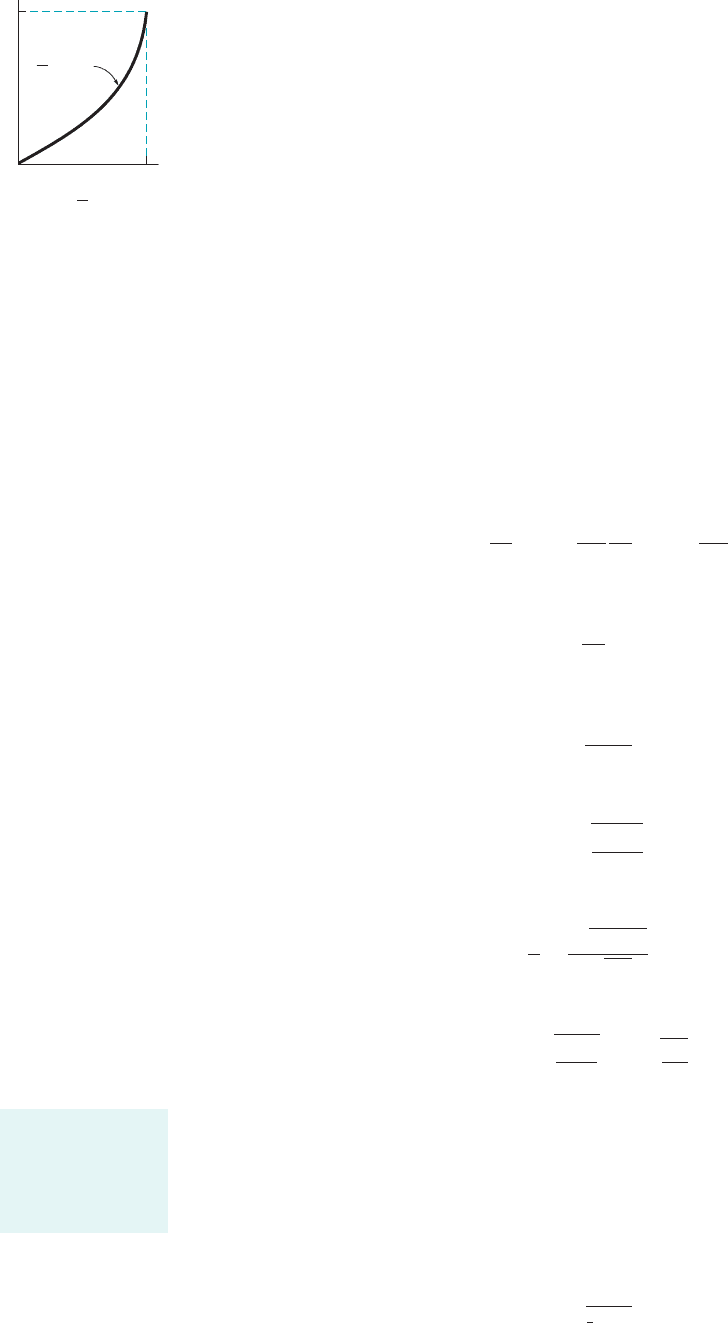
approximation to the boundary layer profile, as shown by the figure in the margin. In partic-
ular, it should certainly satisfy the boundary conditions at and at
That is,
The linear function used in Example 9.4 is one such possible profile. Other conditions,
such as at could also be incorporated into the func-
tion to more closely approximate the actual profile.
For a given the drag can be determined from Eq. 9.22 as
or
(9.27)
where the dimensionless constant has the value
Also, the wall shear stress can be written as
(9.28)
where the dimensionless constant has the value
By combining Eqs. 9.25, 9.27, and 9.28 we obtain
which can be integrated from at to give
or
(9.29)
By substituting this expression back into Eqs. 9.28 we obtain
(9.30)
To use Eqs. 9.29 and 9.30 we must determine the values of and Several assumed ve-
locity profiles and the resulting values of are given in Fig. 9.12 and Table 9.2. The more closely
the assumed shape approximates the actual 1i.e., Blasius2profile, the more accurate the final re-
sults. For any assumed profile shape, the functional dependence of and on the physical para-
meters and x is the same. Only the constants are different. That is, or
and where
It is often convenient to use the dimensionless local friction coefficient, defined as
(9.31)c
f
⫽
t
w
1
2
rU
2
c
f
,
Re
x
⫽ rUx
Ⲑ
m.t
w
⬃ 1rmU
3
Ⲑ
x2
1
Ⲑ
2
,dRe
1
Ⲑ
2
x
Ⲑ
x ⫽ constant,
d ⬃ 1mx
Ⲑ
rU2
1
Ⲑ
2
r, m, U,
t
w
d
d
C
2
.C
1
t
w
⫽
B
C
1
C
2
2
U
3
Ⲑ
2
A
rm
x
d
x
⫽
12C
2
Ⲑ
C
1
1Re
x
d ⫽
B
2nC
2
x
UC
1
x ⫽ 0d ⫽ 0
d dd ⫽
mC
2
rUC
1
dx
C
2
⫽
dg
dY
`
Y⫽0
C
2
t
w
⫽ m
0u
0y
`
y⫽0
⫽
mU
d
dg
dY
`
Y⫽0
⫽
mU
d
C
2
C
1
⫽
冮
1
0
g1Y231 ⫺ g1Y24 dY
C
1
d ⫽ rbU
2
dC
1
d ⫽ rb
冮
d
0
u1U ⫺ u2 dy ⫽ rbU
2
d
冮
1
0
g1Y231 ⫺ g1Y24 dY
g1Y2,
g1Y2
1i.e., 0u
Ⲑ
0y ⫽ 0 at y ⫽ d2,Y ⫽ 1dg
Ⲑ
dY ⫽ 0
g1Y2⫽ Y
g102⫽ 0
and
g112⫽ 1
y ⫽ d.u ⫽ Uy ⫽ 0u ⫽ 0
9.2 Boundary Layer Characteristics 481
Y
0
1
01
=
g(Y)
U
u
U
u
Approximate
boundary layer re-
sults are obtained
from the momentum
integral equation.
JWCL068_ch09_461-533.qxd 9/23/08 11:47 AM Page 481

to express the wall shear stress. From Eq. 9.30 we obtain the approximate value
while the Blasius solution result is given by
(9.32)
These results are also indicated in Table 9.2.
For a flat plate of length and width b, the net friction drag, can be expressed in terms
of the friction drag coefficient, as
or
(9.33)C
Df
⫽
1
/
冮
/
0
c
f
dx
C
Df
⫽
d
f
1
2
rU
2
b/
⫽
b
冮
/
0
t
w
dx
1
2
rU
2
b/
C
Df
,
d
f
,/
c
f
⫽
0.664
1Re
x
c
f
⫽ 12C
1
C
2
A
m
rUx
⫽
12C
1
C
2
1Re
x
482 Chapter 9 ■ Flow over Immersed Bodies
Parabolic
Blasius
Sine wave
Cubic
Linear
1.00.50
0
0.5
1.0
y
_
_
δ
u
__
U
F I G U R E 9.12 Typical
approximate boundary layer profiles
used in the momentum integral equation.
TABLE 9.2
Flat Plate Momentum Integral Results for Various Assumed
Laminar Flow Velocity Profiles
Profile Character
a. Blasius solution 5.00 0.664 1.328
b. Linear
3.46 0.578 1.156
c. Parabolic
5.48 0.730 1.460
d. Cubic
4.64 0.646 1.292
e. Sine wave
4.79 0.655 1.310u
Ⲑ
U ⫽ sin3p1y
Ⲑ
d2
Ⲑ
24
u
Ⲑ
U ⫽ 31y
Ⲑ
d2
Ⲑ
2 ⫺ 1y
Ⲑ
d2
3
Ⲑ
2
u
Ⲑ
U ⫽ 2y
Ⲑ
d ⫺ 1y
Ⲑ
d2
2
u
Ⲑ
U ⫽ y
Ⲑ
d
C
Df
Re
ᐍ
1
Ⲑ
2
c
f
Re
x
1
Ⲑ
2
DRe
x
1
Ⲑ
2
Ⲑ
x
The friction drag
coefficient is an in-
tegral of the local
friction coefficient.
JWCL068_ch09_461-533.qxd 9/23/08 11:47 AM Page 482

We use the above approximate value of to obtain
where is the Reynolds number based on the plate length. The corresponding value ob-
tained from the Blasius solution 1Eq. 9.322and shown by the figure in the margin gives
These results are also indicated in Table 9.2.
The momentum integral boundary layer method provides a relatively simple technique to ob-
tain useful boundary layer results. As is discussed in Sections 9.2.5 and 9.2.6, this technique can
be extended to boundary layer flows on curved surfaces 1where the pressure and fluid velocity at
the edge of the boundary layer are not constant2and to turbulent flows.
9.2.4 Transition from Laminar to Turbulent Flow
The analytical results given in Table 9.2 are restricted to laminar boundary layer flows along a flat
plate with zero pressure gradient. They agree quite well with experimental results up to the point
where the boundary layer flow becomes turbulent, which will occur for any free-stream velocity
and any fluid provided the plate is long enough. This is true because the parameter that governs
the transition to turbulent flow is the Reynolds number—in this case the Reynolds number based
on the distance from the leading edge of the plate,
The value of the Reynolds number at the transition location is a rather complex function of
various parameters involved, including the roughness of the surface, the curvature of the surface 1for
example, a flat plate or a sphere2, and some measure of the disturbances in the flow outside the
boundary layer. On a flat plate with a sharp leading edge in a typical airstream, the transition takes
place at a distance x from the leading edge given by to Unless otherwise
stated, we will use in our calculations.
The actual transition from laminar to turbulent boundary layer flow may occur over a region
of the plate, not at a specific single location. This occurs, in part, because of the spottiness of the
transition. Typically, the transition begins at random locations on the plate in the vicinity of
These spots grow rapidly as they are convected downstream until the entire width of the
plate is covered with turbulent flow. The photo shown in Fig. 9.13 illustrates this transition process.
The complex process of transition from laminar to turbulent flow involves the instability of the
flow field. Small disturbances imposed on the boundary layer flow 1i.e., from a vibration of the plate,
a roughness of the surface, or a “wiggle” in the flow past the plate2will either grow 1instability2or
decay 1stability2, depending on where the disturbance is introduced into the flow. If these disturbances
occur at a location with they will die out, and the boundary layer will return to laminar
flow at that location. Disturbances imposed at a location with will grow and transform
the boundary layer flow downstream of this location into turbulence. The study of the initiation,
growth, and structure of these turbulent bursts or spots is an active area of fluid mechanics research.
Re
x
7 Re
xcr
Re
x
6 Re
xcr
Re
x
⫽ Re
xcr
.
Re
xcr
⫽ 5 ⫻ 10
5
3 ⫻ 10
6
.Re
xcr
⫽ 2 ⫻ 10
5
Re
x
⫽ Ux
Ⲑ
n.
C
Df
⫽
1.328
1Re
/
Re
/
⫽ U/
Ⲑ
n
C
Df
⫽
18C
1
C
2
1Re
/
c
f
⫽ 12C
1
C
2
m
Ⲑ
rUx2
1
Ⲑ
2
9.2 Boundary Layer Characteristics 483
0.04
0.03
Laminar
boundary
layer
0.02
0.01
0.00
Re
ᐉ
C
Df
F I G U R E 9.13
Turbulent spots and the tran-
sition from laminar to turbulent
boundary layer flow on a flat
plate. Flow from left to right.
(Photograph courtesy of
B. Cantwell, Stanford University.)
V9.5 Transition on
flat plate
The boundary layer
on a flat plate will
become turbulent if
the plate is long
enough.
JWCL068_ch09_461-533.qxd 9/23/08 11:47 AM Page 483
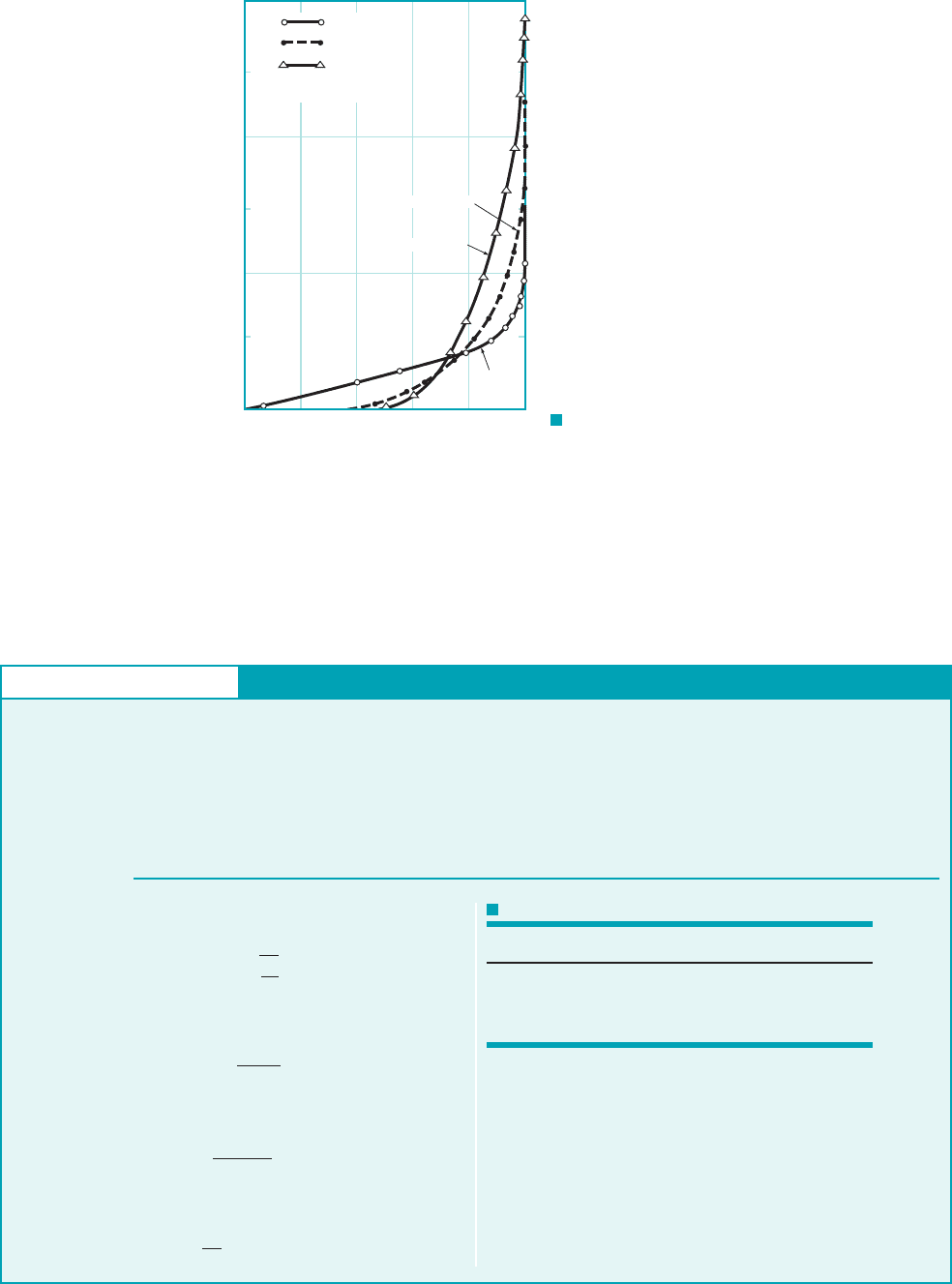
Transition from laminar to turbulent flow also involves a noticeable change in the shape of
the boundary layer velocity profile. Typical profiles obtained in the neighborhood of the transition
location are indicated in Fig. 9.14. The turbulent profiles are flatter, have a larger velocity gradi-
ent at the wall, and produce a larger boundary layer thickness than do the laminar profiles.
484 Chapter 9 ■ Flow over Immersed Bodies
F I G U R E 9.14 Typical boundary layer
profiles on a flat plate for laminar, transitional, and turbu-
lent flow (Ref. 1).
x = 5.25 ft
x = 6.76 ft
x = 8.00 ft
U = 89 ft/s; air flow
Transitional
Turbulent
Laminar
0.06
0.05
0.04
0.03
0.02
0.01
0
y, ft
0 0.2 0.4 0.6 0.8 1
u
__
U
GIVEN A fluid flows steadily past a flat plate with a velocity
of
FIND At approximately what location will the boundary layer
become turbulent, and how thick is the boundary layer at that
U ⫽ 10 ft
Ⲑ
s.
point if the fluid is 1a2water at 1b2standard air, or
1c2glycerin at 68 °F?
60 °F,
S
OLUTION
Boundary Layer Transition
where is in and and are in feet. The values of the
kinematic viscosity obtained from Tables 1.5 and 1.7 are listed in
Table E9.5 along with the corresponding and
COMMENT Laminar flow can be maintained on a longer
portion of the plate if the viscosity is increased. However, the
boundary layer flow eventually becomes turbulent, provided the
plate is long enough. Similarly, the boundary layer thickness is
greater if the viscosity is increased.
d
cr
.x
cr
d
cr
x
cr
ft
2
Ⲑ
sn
E
XAMPLE 9.5
For any fluid, the laminar boundary layer thickness is found from
Eq. 9.15 as
The boundary layer remains laminar up to
Thus, if we assume we obtain
and
d
cr
d 0
x⫽x
cr
⫽ 5c
n
10
15 ⫻ 10
4
n2d
1
Ⲑ
2
⫽ 354 n
x
cr
⫽
5 ⫻ 10
5
10 ft
Ⲑ
s
n ⫽ 5 ⫻ 10
4
n
Re
xcr
⫽ 5 ⫻ 10
5
x
cr
⫽
nRe
xcr
U
d ⫽ 5
A
nx
U
TABLE E9.5
Fluid ( ) (ft) (ft)
a. Water 0.605 0.00428
b. Air 7.85 0.0556
c. Glycerin 640.0 4.53 1.28 ⫻ 10
⫺2
1.57 ⫻ 10
⫺4
1.21 ⫻ 10
⫺5
D
cr
x
cr
ft
2
Ⲑ
sN
(Ans)
JWCL068_ch09_461-533.qxd 9/23/08 11:47 AM Page 484

9.2.5 Turbulent Boundary Layer Flow
The structure of turbulent boundary layer flow is very complex, random, and irregular. It shares
many of the characteristics described for turbulent pipe flow in Section 8.3. In particular, the veloc-
ity at any given location in the flow is unsteady in a random fashion. The flow can be thought of as
a jumbled mix of intertwined eddies 1or swirls2of different sizes 1diameters and angular velocities2.
The figure in the margin shows a laser-induced fluorescence visualization of a turbulent boundary
layer on a flat plate (side view). The various fluid quantities involved 1i.e., mass, momentum, en-
ergy2are convected downstream in the free-stream direction as in a laminar boundary layer. For tur-
bulent flow they are also convected across the boundary layer 1in the direction perpendicular to the
plate2by the random transport of finite-sized fluid particles associated with the turbulent eddies.
There is considerable mixing involved with these finite-sized eddies—considerably more than is
associated with the mixing found in laminar flow where it is confined to the molecular scale. Al-
though there is considerable random motion of fluid particles perpendicular to the plate, there is
very little net transfer of mass across the boundary layer—the largest flowrate by far is parallel to
the plate.
There is, however, a considerable net transfer of x component of momentum perpendicular
to the plate because of the random motion of the particles. Fluid particles moving toward the plate
1in the negative y direction2have some of their excess momentum 1they come from areas of higher
velocity2removed by the plate. Conversely, particles moving away from the plate 1in the positive
y direction2gain momentum from the fluid 1they come from areas of lower velocity2. The net re-
sult is that the plate acts as a momentum sink, continually extracting momentum from the fluid.
For laminar flows, such cross-stream transfer of these properties takes place solely on the mole-
cular scale. For turbulent flow the randomness is associated with fluid particle mixing. Conse-
quently, the shear force for turbulent boundary layer flow is considerably greater than it is for
laminar boundary layer flow 1see Section 8.3.22.
There are no “exact” solutions for turbulent boundary layer flow. As is discussed in Section
9.2.2, it is possible to solve the Prandtl boundary layer equations for laminar flow past a flat plate
to obtain the Blasius solution 1which is “exact” within the framework of the assumptions involved
in the boundary layer equations2. Since there is no precise expression for the shear stress in turbu-
lent flow 1see Section 8.32, solutions are not available for turbulent flow. However, considerable
headway has been made in obtaining numerical 1computer2solutions for turbulent flow by using
approximate shear stress relationships. Also, progress is being made in the area of direct, full nu-
merical integration of the basic governing equations, the Navier–Stokes equations.
Approximate turbulent boundary layer results can also be obtained by use of the momen-
tum integral equation, Eq. 9.26, which is valid for either laminar or turbulent flow. What is
needed for the use of this equation are reasonable approximations to the velocity profile
where and u is the time-averaged velocity 1the overbar notation, of Sec-
tion 8.3.2 has been dropped for convenience2, and a functional relationship describing the wall
shear stress. For laminar flow the wall shear stress was used as In theory,
such a technique should work for turbulent boundary layers also. However, as is discussed in
Section 8.3, the details of the velocity gradient at the wall are not well understood for turbulent
flow. Thus, it is necessary to use some empirical relationship for the wall shear stress. This is
illustrated in Example 9.6.
t
w
m10u
0y2
y0
.
u,Y y
du U g1Y2,
9.2 Boundary Layer Characteristics 485
Random transport
of finite-sized fluid
particles occurs
within turbulent
boundary layers.
Plate
GIVEN Consider turbulent flow of an incompressible fluid
past a flat plate. The boundary layer velocity profile is assumed
to be for and for
as shown in Fig. E9.6. This is a reasonable approxima-
tion of experimentally observed profiles, except very near the
plate where this formula gives at Note the
differences between the assumed turbulent profile and the lami-
nar profile. Also assume that the shear stress agrees with the
y 0.0u
0y q
Y 7 1
u UY y
d 1u
U 1y
d2
1
7
Y
1
7
experimentally determined formula:
(1)
FIND Determine the boundary layer thicknesses and
and the wall shear stress, as a function of x. Determine the
friction drag coefficient, C
Df
.
t
w
,
™d, d*,
t
w
0.0225rU
2
a
n
Ud
b
1
4
Turbulent Boundary Layer Properties
E
XAMPLE 9.6
JWCL068_ch09_461-533.qxd 9/23/08 11:47 AM Page 485
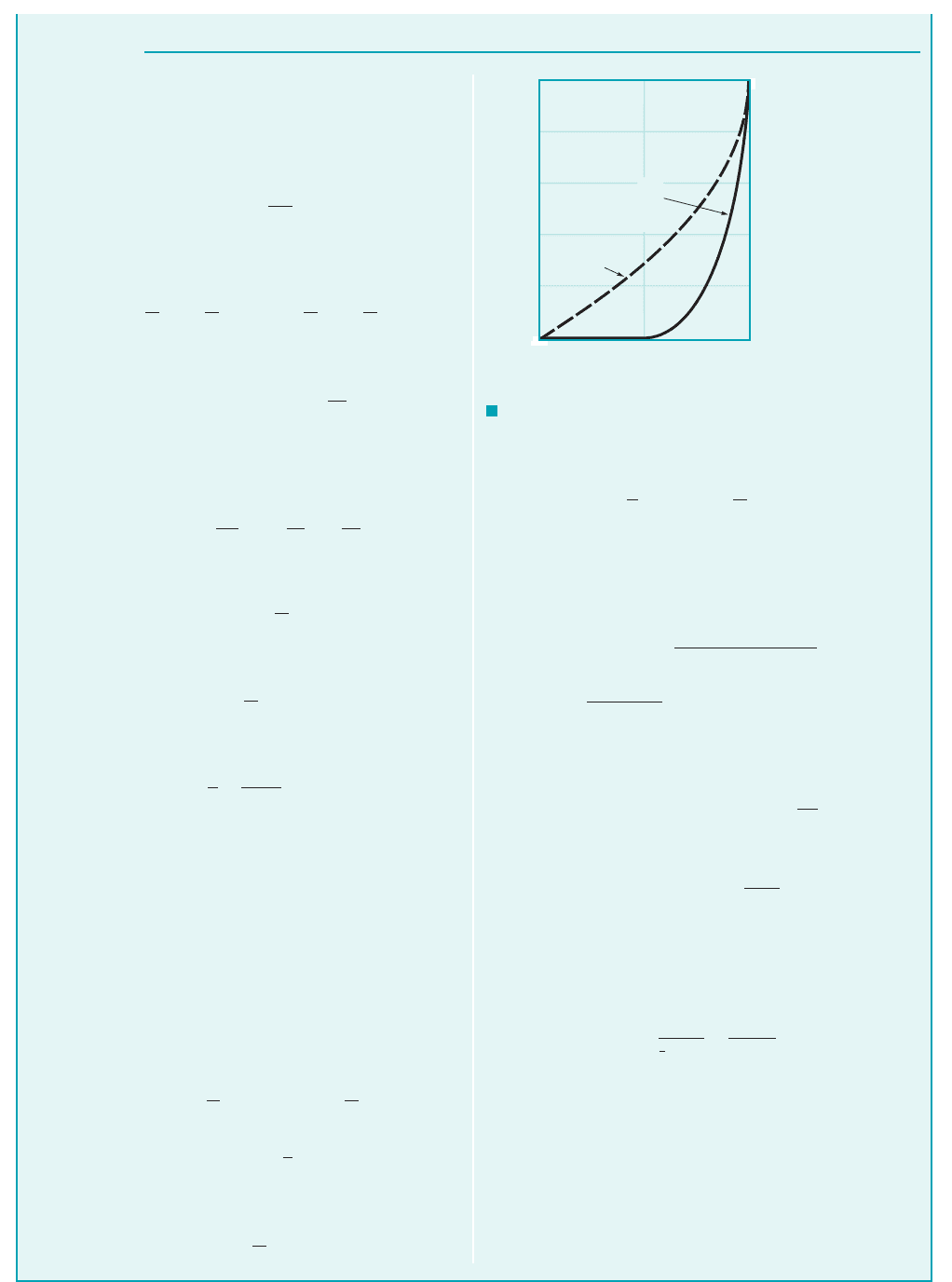
486 Chapter 9 ■ Flow over Immersed Bodies
S
OLUTION
Similarly, from Eq. 2,
(4) (Ans)
The functional dependence for and is the same; only the
constants of proportionality are different. Typically,
By combining Eqs. 1 and 3, we obtain the following result for
the wall shear stress
(Ans)
This can be integrated over the length of the plate to obtain the
friction drag on one side of the plate, as
or
where is the area of the plate. 1This result can also be ob-
tained by combining Eq. 9.23 and the expression for the momen-
tum thickness given in Eq. 4.2The corresponding friction drag
coefficient, is
(Ans)
COMMENT Note that for the turbulent boundary layer flow
the boundary layer thickness increases with x as and the
shear stress decreases as For laminar flow these de-
pendencies are and respectively. The random charac-
ter of the turbulent flow causes a different structure of the flow.
Obviously the results presented in this example are valid only
in the range of validity of the original data—the assumed veloc-
ity profile and shear stress. This range covers smooth flat plates
with 5 ⫻ 10
5
6 Re
/
6 10
7
.
x
⫺1
Ⲑ
2
,x
1
Ⲑ
2
t
w
⬃ x
⫺1
Ⲑ
5
.
d ⬃ x
4
Ⲑ
5
C
Df
⫽
d
f
1
2
rU
2
A
⫽
0.0720
Re
/
1
Ⲑ
5
C
Df
,
A ⫽ b/
d
f
⫽ 0.0360rU
2
A
Re
/
1
Ⲑ
5
d
f
⫽
冮
/
0
bt
w
dx ⫽ b10.0288rU
2
2
冮
/
0
a
n
Ux
b
1
Ⲑ
5
dx
d
f
,
⫽
0.0288rU
2
Re
x
1
Ⲑ
5
t
w
⫽ 0.0225rU
2
c
n
U10.37021n
Ⲑ
U2
1
Ⲑ
5
x
4
Ⲑ
5
d
1
Ⲑ
4
™6d* 6 d.
™d, d*,
™ ⫽
7
72
d ⫽ 0.0360 a
n
U
b
1
Ⲑ
5
x
4
Ⲑ
5
Whether the flow is laminar or turbulent, it is true that the drag
force is accounted for by a reduction in the momentum of the
fluid flowing past the plate. The shear is obtained from Eq. 9.26
in terms of the rate at which the momentum boundary layer thick-
ness, increases with distance along the plate as
For the assumed velocity profile, the boundary layer momen-
tum thickness is obtained from Eq. 9.4 as
or by integration
(2)
where is an unknown function of x. By combining the assumed
shear force dependence 1Eq. 12with Eq. 2, we obtain the follow-
ing differential equation for
or
This can be integrated from at to obtain
(3)
(Ans)
or in dimensionless form
Strictly speaking, the boundary layer near the leading edge of
the plate is laminar, not turbulent, and the precise boundary
condition should be the matching of the initial turbulent bound-
ary layer thickness 1at the transition location2with the thickness
of the laminar boundary layer at that point. In practice, how-
ever, the laminar boundary layer often exists over a relatively
short portion of the plate, and the error associated with starting
the turbulent boundary layer with at can be negli-
gible.
The displacement thickness, and the momentum thickness,
can be obtained from Eqs. 9.3 and 9.4 by integrating as fol-
lows:
Thus, by combining this with Eq. 3 we obtain
(Ans)
d* ⫽ 0.0463 a
n
U
b
1
Ⲑ
5
x
4
Ⲑ
5
⫽ d
冮
1
0
11 ⫺ Y
1
Ⲑ
7
2 dY ⫽
d
8
d* ⫽
冮
q
0
a1 ⫺
u
U
b dy ⫽ d
冮
1
0
a1 ⫺
u
U
b dY
™,
d*,
x ⫽ 0d ⫽ 0
d
x
⫽
0.370
Re
x
1
Ⲑ
5
d ⫽ 0.370 a
n
U
b
1
Ⲑ
5
x
4
Ⲑ
5
x ⫽ 0d ⫽ 0
d
1
Ⲑ
4
dd ⫽ 0.231 a
n
U
b
1
Ⲑ
4
dx
0.0225rU
2
a
n
Ud
b
1
Ⲑ
4
⫽
7
72
rU
2
dd
dx
d:
d
™ ⫽ d
冮
1
0
Y
1
Ⲑ
7
11 ⫺ Y
1
Ⲑ
7
2 dY ⫽
7
72
d
™ ⫽
冮
q
0
u
U
a1 ⫺
u
U
b dy ⫽ d
冮
1
0
u
U
a1 ⫺
u
U
b dY
t
w
⫽ rU
2
d™
dx
™,
F I G U R E E9.6
Laminar
u
__
U
u
__
U
=
y
__
δ
y
__
δ
Turbulent
1.00.50
0
0.2
0.4
0.6
0.8
1.0
Y =
(
)
1
__
7
JWCL068_ch09_461-533.qxd 9/23/08 11:47 AM Page 486
